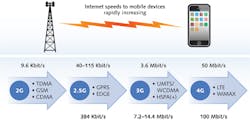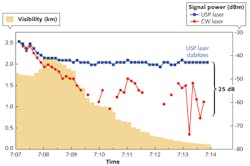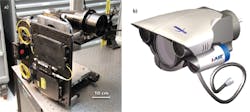ADVANCES IN COMMUNICATIONS: New FSO provides reliable 10 Gbit/s and beyond backhaul connections
ISAAC KIM, TOM CHAFFEE, ROBERT FLEISHAUER, PAUL SZAJOWSKI, ALEXANDRE BRAGA, DAVID BEERING, and DANIEL C. HURLEY
Cellular carriers face a growing challenge to increase the backhaul capacity between cell towers to keep up with the rapidly increasing number of mobile users employing 4G technology to access the Internet. The only viable backhaul options for a full 4G network include deploying fiber-optic cables (which can be very time consuming and expensive), or installing wireless free-space optical (FSO) technology between cell towers.
Unfortunately, FSO signals can degrade due to the presence of fog and turbulence, which has prevented legacy FSO systems-that used continuous-wave (CW) lasers-from reaching the 2 to 3 km backhaul link range.1,2 However, experiments by Attochron with new FSO systems incorporating ultrashort pulse (USP) lasers show much better performance and can provide 1 Gbit/s backhaul capacity today and 10 Gbit/s and higher in the future without having to deploy fiber-optic cables.The backhaul bottleneck
As individual mobile Internet downloads increase from 2G speeds of 10 kbit/s to 4G speeds of 100 Mbit/s, the added outbound traffic places a tremendous strain on the cellular tower backhaul (see Fig. 1).3 Most cell towers depend on slower microwave backhaul connections that realistically top out at 100 Mbit/s, restricting how many users can be connected at 4G speeds (see Fig. 2). If a faster wireless technology can be deployed between cell towers, the number of 4G users can increase along with a corresponding increase in carrier revenues (see table).A 20 Gbit/s fiber-optic connection to a cellular tower allows up to 200 mobile users to individually download from the Internet at full 4G, 100 Mbit/s speeds. However, former Verizon CEO Ivan Seidenberg claimed on the June 22, 2009 Charlie Rose Show that fiber optics will reach no more than 30% of a carrier's footprint. JDSU marketing experts estimate that of the one million cell towers built by the end of 2014, 50% will require more capacity than any non‐fiber media can provide, and carriers will not be able to afford fiber optics—leaving 500,000 cell towers without a viable backhaul solution. The cost-effective wireless alternative to fiber-optic cables is FSO technology.4,5
Free-space optics
Legacy FSO systems work well in clear or hazy weather at distances up to 1.5 km, but the presence of fog can reduce effective link distances to 200 m.5 And while one option to improve visibility is to make the light brighter, this is not possible because the light then becomes unsafe to the eyes.6 Using flashing or strobe lights is another option; USP lasers behave similarly, but the pulses of light flash on a much shorter time scale—as short as a few femtoseconds.7FSO signals are also subject to atmospheric scintillation that can cause receive-power fluctuations and fading and burst errors for longer link distances (similar to a star twinkling at night).8 We measured an increase in receive power of up to 15 dB in clear-air turbulence using a USP laser over a CW laser. These empirical observations correlate well to theoretical work done by G. P. Berman and colleagues at Los Alamos National Laboratory.9
This product design will incorporate four transmit apertures that allow more transmit power while maintaining eye safety. Multiple transmit apertures further reduce atmospheric scintillation because the four paths will independently sample slightly different portions of the atmosphere. These four paths will have different fluctuation patterns, and the summation of these four signals into the receive aperture will have fewer overall fluctuations.10 The receive telescope will be 8 to 12 in. in diameter and incorporate fine-steering mirrors for tracking.
In preliminary testing of our prototype USP laser-based FSO systems, the 25 dB additional margin improves link availability at 1 Gbit/s to 99.5% at 3 km; pulse modulation techniques now in development will further increase the bandwidth to 10 Gbit/s and beyond.
Pulse-shaping efficiencies
Pulse‐modulation techniques manipulate the laser pulse shape before transmission to achieve greater transmission efficiencies and optimize various desirable propagation effects. Binary phase shift keying (BPSK) pulse modulation has been used in satellite laser communication to increase overall bandwidth to 6 Gbit/s.11 Fiber-optic systems use BPSK, quadrature phase shift keying (QPSK), and 16-quadrature amplitude modulation (16-QAM) to increase bandwidth from 10 to 400 Gbit/s.
Since the USP is much narrower in time (100 fs), it has much broader spectral content than CW laser pulses in conventional fiber-optic systems. Our "pulseshaper" technology decomposes the bandwidth of a single USP laser into many discrete spectral "bins" that can be independently modulated, and then recombined to produce a new single pulse with a modified temporal shape.12 For example, by using 10 spectral bins, each with its own signaling, a 1 Gbit/s signal can be increased to 10 Gbit/s. Modulating 100 spectral bins will result in 100 Gbit/s overall.
Of course, the modulation and demodulation of these shaped USPs will require very fast digital signal processing (DSP). Fortunately, these DSP capabilities—which have been used in 100 Gbit/s and higher fiber-optic systems—are now available on an optical chip and will be incorporated in the USP FSO systems.
These advanced modulation schemes will extend wireless backhaul capacity to 10 Gbit/s and even 100 Gbit/s between cell towers. This will greatly speed the deployment of full 4G networks by cellular carriers and even be sufficient for future 5G cellular networks.13
REFERENCES
1. W. K. Pratt, Laser Communication Systems, J. Wiley & Sons, New York, NY (1969).
2. I. I. Kim et al., SPIE Opt. Eng., 37, 3143–3155 (1998).
3. NGMN Alliance, "Guidelines for LTE Backhaul Traffic Estimation" (2011).
4. T. H. Carbonneau and D. R. Wisely, "Opportunities and challenges for optical wireless; the competitive advantage of free-space telecommunications links in today's crowded marketplace," Proc. SPIE, 3232, 119–128 (1998).
5. I. I. Kim, Lightwave, 26, 19–21 (2009).
6. "American National Standard for Safe Use of Lasers (ANSI Z136.1‐1993)," the Laser Institute of America, Orlando, FL (1993).
7. J. M. Hopkins and W. Sibbett, Sci. Amer., 283, 72–79 (2000).
8. I. I. Kim et al., "Measurement of scintillation for free-space laser communication at 785 nm and 1550 nm," Proc. SPIE, 3850, 49–62 (1999).
9. G. P. Berman et al., J. Phys. B: At. Mol.Opt. Phys., 44, 55402–55421 (2011).
10. I. I. Kim et al., "Scintillation reduction using multiple transmitters," Proc. SPIE, 2990, 102–113 (1997).
11. B. Smutny et al., "5.625 Gbit/s optical inter-satellite communication link verified in-orbit," Proc. Ka and Broadband Communications Conference, Matera, Italy (2008).
12. See http://bit.ly/14Pu7KC.
13. P.E. Mogensen et al., "LTE-Advanced: The path towards gigabit/s in wireless mobile communications," Wireless VITAE 2009, 147–151, Aalborg, Denmark (May 2009).
Isaac Kim is CTO, Tom Chaffee is founder and CEO, Robert Fleishauer is VP of atmospheric R&D, Paul Szajowski is Consultant, Optical Sciences, Alexandre Braga is USPL sciences advisor, David Beering is VP laser SATCOM business development, and Daniel C. Hurley, Jr., is VP Washington, DC affairs at Attochron, PO Box 1036, Lexington, VA 24450; email: [email protected]; www.attochron.com.





